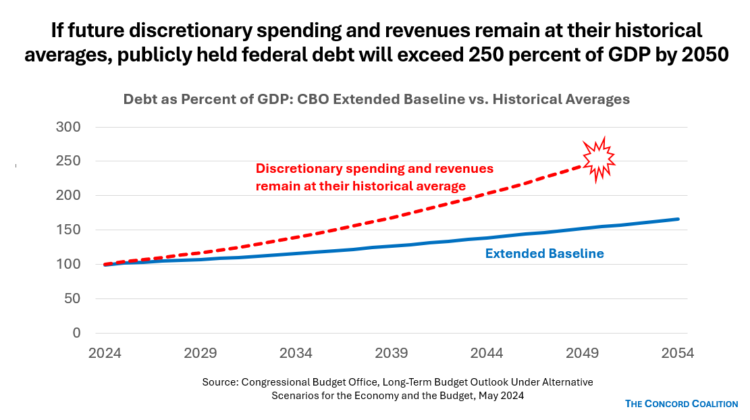A new analysis by the Congressional Budget Office (CBO) suggests that if history is any guide, our nation’s debt could become far more burdensome over the next 30 years than projected under current law. That’s an alarming prospect because the debt is already projected to reach a record shattering 166 percent of the gross domestic product (GDP) in 2054.
Standard CBO baseline projections assume that current laws regarding spending and tax policy remain unchanged. The 30-year projection is called the “extended baseline.” Because appropriations (discretionary spending) are enacted on an annual basis, CBO assumes that they will grow with inflation from the most recently enacted level over the next 10 years and then gradually transition to grow at the same rate as nominal GDP.
Under these assumptions, CBO’s extended baseline projects that discretionary spending will shrink from 6.2 percent of GDP this year to 4.9 percent of GDP in 2036 and beyond . Baseline revenues grow from 17.5 percent of GDP this year to 18.8 percent in 2049. That combination has a positive effect on the budget, although not by nearly enough to prevent deficits and debt from continuing to rise beyond historical levels due to projected increases in mandatory spending, such as Social Security and Medicare, and growing interest on the debt.
In its recent analysis, CBO prepared an alternative scenario illustrating how the extended baseline would change if discretionary spending and revenues equal the same share of GDP over the next 30 years as they have averaged over the past 30 years. Mandatory spending is assumed to grow as projected under current law.
By those measures, annual discretionary spending is set at 7.0 percent of GDP in all years, rather than averaging 5.1 percent of GDP as projected in the extended baseline. Annual revenues in this scenario are set at 17.2 percent of GDP, rather than averaging 18.2 percent of GDP as projected in the extended baseline.
This is not an implausible scenario since it reflects the average outcome of policy choices over the past 30 years. The negative effect on the budget, however, would be dramatic. The combined result of higher discretionary spending and lower revenues, while consistent with the past 30-year average, would increase the projected debt in 2049 to 244 percent of GDP as opposed to 152 percent under the extended baseline. The CBO does not project a debt number beyond 250 percent of GDP. This is not because the agency considers that level to be a “fiscal tipping point,” but because debt at that level would require the agency to reevaluate its current models.
As CBO explains, “The agency’s long-term budget and economic projections are subject to significant uncertainty, and that uncertainty increases as projected debt expands far beyond historical experience, in part because of the potential economic effects of debt in that case.”

To be sure, there could be some long-term economic benefits from higher discretionary spending if it were devoted to federal investments in research, development, education, and infrastructure. Lower revenues could also have economic benefits, such as encouraging more work, saving, and investment. However, these pro-growth benefits would be swamped by the negative economic effect of high and rising debt. According to CBO, real Gross National Product (GNP) per capita would be $6,200 lower in 2049 under this scenario than in the extended baseline. By contrast, in an alternative CBO scenario where the debt-to-GDP ratio remains at 99 percent over the next 30 years (its current level), real GNP per capita would be $5,500 higher in 2054.
As Congress considers proposals to either raise discretionary spending or cut taxes, the CBO Historical Average scenario serves as a useful reminder that current law – already unsustainable over the long-term – assumes just the opposite: a substantial decrease in discretionary spending and a substantial increase in revenues, relative to our recent past experience.
By implication, this scenario also demonstrates the folly of exempting mandatory programs from scrutiny. The historical 30-year averages strongly suggest that it will be difficult to achieve the discretionary spending cuts and revenue increases assumed in the baseline. Even more difficult, however, will be preventing demographic changes and healthcare costs from driving mandatory spending to much higher levels. Any realistic path to putting the budget on a sustainable basis will need a comprehensive approach.




